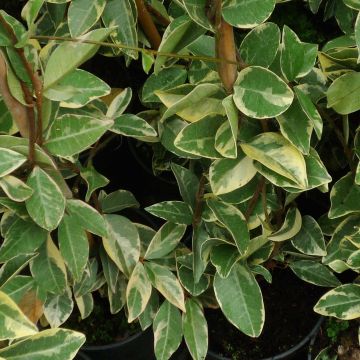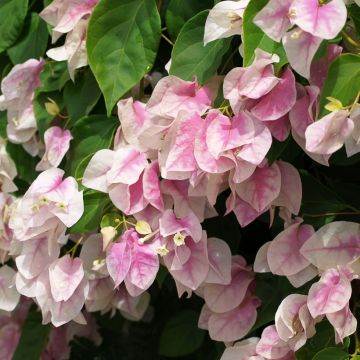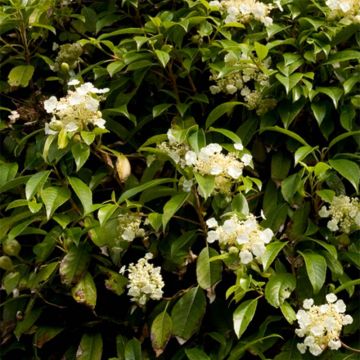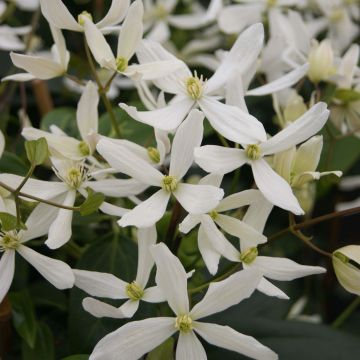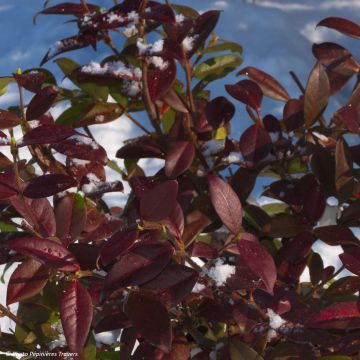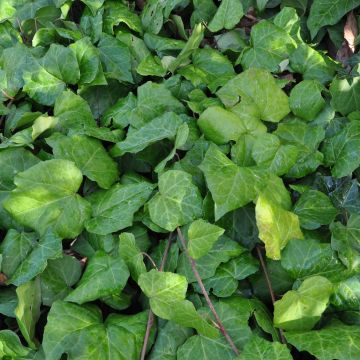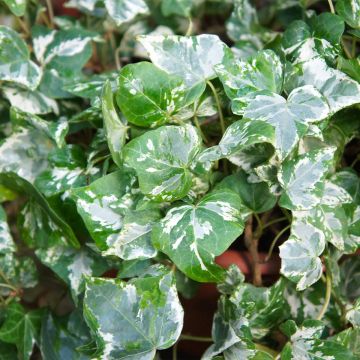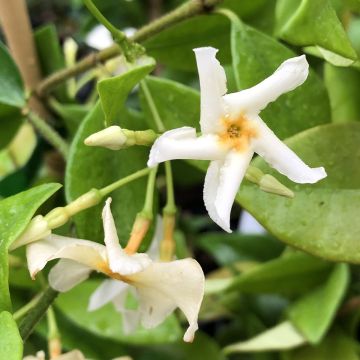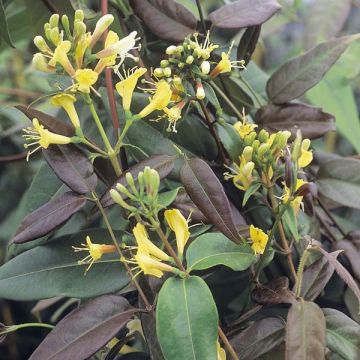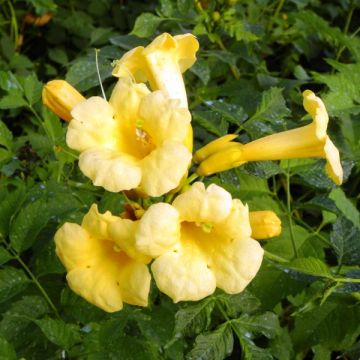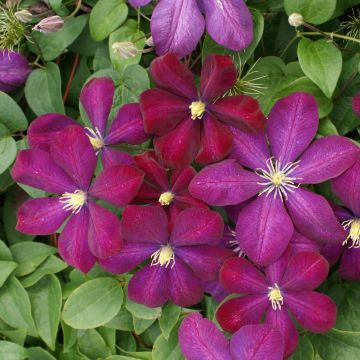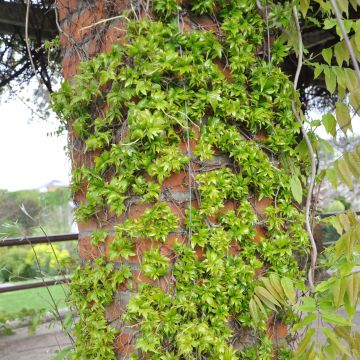

Decumaria barbara Vicki - Woodvamp
Decumaria barbara Vicki - Woodvamp
Decumaria barbara Vicki
Climbing hydrangea, Woodvamp
Why not try an alternative variety in stock?
View all →This plant carries a 6 months recovery warranty
More information
We guarantee the quality of our plants for a full growing cycle, and will replace at our expense any plant that fails to recover under normal climatic and planting conditions.
From €5.90 for pickup delivery and €6.90 for home delivery
Express home delivery from €8.90.
Does this plant fit my garden?
Set up your Plantfit profile →
Description
The Decumaria barbara ‘Vicki’, sometimes called climbing hydrangea, is a vigorous climbing plant from the Hydrangeaceae family. This variety can cling to vertical surfaces using climbing root stems, similar to ivy. This liana offers an abundant flowering of fragrant white umbels in late spring and early summer. Like climbing hydrangeas, it is used to adorn shady walls or pergolas. Its cultivation is best suited to relatively mild and humid regions in our country, in a cool, well-drained soil, in a semi-shaded position sheltered from cold winds.
Belonging to the Hydrangeaceae family, Decumaria barbara is a fast-growing, evergreen liana, capable of reaching a height of 8 to 10 meters by clinging to supports with adventitious roots that develop on its long stems. This species is native to the humid forests of the southeastern United States, where it mainly thrives in shaded and humid areas such as valley bottoms and riparian forests.
The cultivar ‘Vicki’, selected by the botanist Michael Dirr, stands out for its semi-evergreen foliage, bright green in summer turning to golden yellow in autumn. The oval leaves measure about 5 to 10 cm long and are glossy. Flowering, which occurs between June and July, takes the form of graceful and fragrant white flower panicles, attracting pollinators. The floral clusters can reach 12 cm in diameter. They consist only of small fertile flowers, exuding a musky and honeyed scent. This flowering, highly visited by pollinating insects, is a treasure for bees. In terms of hardiness, the plant can tolerate temperatures dropping down to -10°/-12 °C when mature.
Decumaria barbara 'Vicki' thrives in partial shade in any humus-rich soil, not overly dry but not waterlogged either. Plant this beautiful liana at the base of a north or west-facing wall, or on the bare trunk of a tree. It can be paired, for example, with plants that thrive in cool partial shade such as its cousin the climbing hydrangea (Hydrangea anomala subsp. petiolaris), or the Hydrangea seemanii, as well as a Clematis montana that prefers shade at its base, it will reach for the sun on its own.
Report an error about the product description
Plant habit
Flowering
Foliage
Botanical data
Decumaria
barbara
Vicki
Hydrangeaceae
Climbing hydrangea, Woodvamp
Cultivar or hybrid
Other Evergreen climbers
Planting and care
To succeed in growing Decumaria barbara ‘Vicki’, plant it in a rich, moist, but well-drained soil, preferably slightly acidic to neutral (pH 6-7). This liana prefers a semi-shaded exposure, although it can tolerate denser shade. It can be planted in full sun in regions with cool and less sunny summers, but a location that is too sunny may dry out the soil, which could harm its growth.
For watering, keep the soil consistently moist, especially during the first years of establishment. It is sensitive to drought and requires regular watering, especially in the summer. Apply organic mulch to retain soil moisture and protect the roots in winter.
The plant climbs using adventitious roots and therefore does not need any particular support. However, if you wish to guide it, plant it near a wall, fence, or tree where it can naturally cling. Pruning is rarely necessary, but you can trim it in spring to control its growth or remove dead branches.
Planting period
Intended location
Care
This item has not been reviewed yet - be the first to leave a review about it.
Summer flowering climbers
Haven't found what you were looking for?
Hardiness is the lowest winter temperature a plant can endure without suffering serious damage or even dying. However, hardiness is affected by location (a sheltered area, such as a patio), protection (winter cover) and soil type (hardiness is improved by well-drained soil).

Photo Sharing Terms & Conditions
In order to encourage gardeners to interact and share their experiences, Promesse de fleurs offers various media enabling content to be uploaded onto its Site - in particular via the ‘Photo sharing’ module.
The User agrees to refrain from:
- Posting any content that is illegal, prejudicial, insulting, racist, inciteful to hatred, revisionist, contrary to public decency, that infringes on privacy or on the privacy rights of third parties, in particular the publicity rights of persons and goods, intellectual property rights, or the right to privacy.
- Submitting content on behalf of a third party;
- Impersonate the identity of a third party and/or publish any personal information about a third party;
In general, the User undertakes to refrain from any unethical behaviour.
All Content (in particular text, comments, files, images, photos, videos, creative works, etc.), which may be subject to property or intellectual property rights, image or other private rights, shall remain the property of the User, subject to the limited rights granted by the terms of the licence granted by Promesse de fleurs as stated below. Users are at liberty to publish or not to publish such Content on the Site, notably via the ‘Photo Sharing’ facility, and accept that this Content shall be made public and freely accessible, notably on the Internet.
Users further acknowledge, undertake to have ,and guarantee that they hold all necessary rights and permissions to publish such material on the Site, in particular with regard to the legislation in force pertaining to any privacy, property, intellectual property, image, or contractual rights, or rights of any other nature. By publishing such Content on the Site, Users acknowledge accepting full liability as publishers of the Content within the meaning of the law, and grant Promesse de fleurs, free of charge, an inclusive, worldwide licence for the said Content for the entire duration of its publication, including all reproduction, representation, up/downloading, displaying, performing, transmission, and storage rights.
Users also grant permission for their name to be linked to the Content and accept that this link may not always be made available.
By engaging in posting material, Users consent to their Content becoming automatically accessible on the Internet, in particular on other sites and/or blogs and/or web pages of the Promesse de fleurs site, including in particular social pages and the Promesse de fleurs catalogue.
Users may secure the removal of entrusted content free of charge by issuing a simple request via our contact form.
The flowering period indicated on our website applies to countries and regions located in USDA zone 8 (France, the United Kingdom, Ireland, the Netherlands, etc.)
It will vary according to where you live:
- In zones 9 to 10 (Italy, Spain, Greece, etc.), flowering will occur about 2 to 4 weeks earlier.
- In zones 6 to 7 (Germany, Poland, Slovenia, and lower mountainous regions), flowering will be delayed by 2 to 3 weeks.
- In zone 5 (Central Europe, Scandinavia), blooming will be delayed by 3 to 5 weeks.
In temperate climates, pruning of spring-flowering shrubs (forsythia, spireas, etc.) should be done just after flowering.
Pruning of summer-flowering shrubs (Indian Lilac, Perovskia, etc.) can be done in winter or spring.
In cold regions as well as with frost-sensitive plants, avoid pruning too early when severe frosts may still occur.
The planting period indicated on our website applies to countries and regions located in USDA zone 8 (France, United Kingdom, Ireland, Netherlands).
It will vary according to where you live:
- In Mediterranean zones (Marseille, Madrid, Milan, etc.), autumn and winter are the best planting periods.
- In continental zones (Strasbourg, Munich, Vienna, etc.), delay planting by 2 to 3 weeks in spring and bring it forward by 2 to 4 weeks in autumn.
- In mountainous regions (the Alps, Pyrenees, Carpathians, etc.), it is best to plant in late spring (May-June) or late summer (August-September).
The harvesting period indicated on our website applies to countries and regions in USDA zone 8 (France, England, Ireland, the Netherlands).
In colder areas (Scandinavia, Poland, Austria...) fruit and vegetable harvests are likely to be delayed by 3-4 weeks.
In warmer areas (Italy, Spain, Greece, etc.), harvesting will probably take place earlier, depending on weather conditions.
The sowing periods indicated on our website apply to countries and regions within USDA Zone 8 (France, UK, Ireland, Netherlands).
In colder areas (Scandinavia, Poland, Austria...), delay any outdoor sowing by 3-4 weeks, or sow under glass.
In warmer climes (Italy, Spain, Greece, etc.), bring outdoor sowing forward by a few weeks.






































